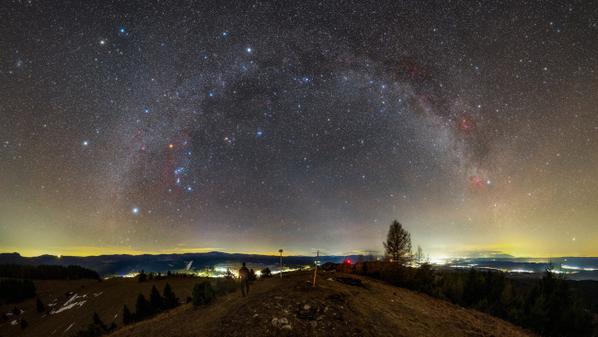This page describes an image Warm Winter Night Over Spiš Region
Caption:
Winner in the 2022 IAU OAE Astrophotography Contest, category Still images of celestial patterns.
This image, taken in Slovakia in January 2022, shows regions of the Milky Way and a rich variety of constellations. The summer constellations of the northern hemisphere are very low in the sky towards the bottom-right. The bright stars of Cygnus and Lyra shine through the artificial lights at the horizon. The huge array of northern winter and autumn constellations with many bright stars are associated with diverse cultural stories.
For the Lakota people in North America the belt of the Orion constellation represents the spine of a bison (“Tayamnicankh”). Orion, the Hunter of Greek mythology, is sometimes described chasing the Seven Sisters, the Pleiades. The Arabs transformed this view by considering the follower of the Pleiades only one star instead of a constellation. Aldebaran, the star in the right eye of Taurus, the Bull, comes from this interpretation, because the name Aldebaran derives from al-dabaran, The Follower.
At the bottom-right, on the horizon, we can see the milky lightcone of the Zodiacal light stretching from the constellation Pisces through Aries, almost reaching the Pleiades, indicating the path of the planets and the Moon in this area. The Pleiades and the Hyades together form a gate on this path, where the heavenly bodies occasionally pass before entering the Milky Way. The planets were considered sheep in ancient Babylon and the modern constellation Orion was considered the “True Shepherd” of the Sky, with his shepherd’s tool reaching the ecliptic. In Roman tradition, the bright white star above the Pleiades and the Milky Way is called Capella, the Goat, which can be traced back to an Egyptian constellation in this area.
Above the treetop in the middle-right part of the image, we see the autumn square, the Andromeda Galaxy and the W-shaped pattern of Cassiopeia. To the left of this group, in the central part of the visible Milky Way, is the constellation Perseus, with Cepheus in the dark area above Cassiopeia completing the celestial family. The Andromeda saga is a Greek story from the area that is now called Israel, and is rooted in Syrian traditions. The location of Andromeda was considered by the ancient Babylonians as the location of the goddess of sexual love, and by the Syrians as the location of the goddess of fertility. According to the saga, Andromeda was chained to a rock at the coast of Jaffa (Tel Aviv) in order to protect her land from a sea monster. The name of the hero who rescued her is Perseus, probably meaning “from Persia” (today’s Iran).
Noticeable in the valley are the lights from towns. The yellow light above the horizon indicates larger cities there, which are given away by their light pollution.
Credit:
Robert Barsa/IAU OAE
DOI: 10.5281/zenodo.7425310
Related glossary terms:
Constellation
, Milky Way
, Orion
, Pisces
, Pleiades
, Taurus
Categories:
Milky Way and Interstellar Medium
, Naked Eye Astronomy
License: Creative Commons Attribution 4.0 International (CC BY 4.0) Creative Commons Attribution 4.0 International (CC BY 4.0) icons
The media file captions presented on the OAE website were written, translated and reviewed by a collective effort from the OAE, the OAE Centers and Nodes, the OAE National Astronomy Education Coordinators (NAECs) and other volunteers. You can find a full list of credits for our translation project here. All media file captions are released under a Creative Commons CC BY-4.0 license and should be credited to "IAU OAE". The media files themselves may have different licenses (see above) and should be credited as listed above under "credit".
Captions in Different Languages:
Caption: Auszeichnung beim IAU OAE Astrofoto-Wettbewerb 2022, Kategorie Weitwinkelaufnahmen von Himmelsmustern.
Dieses Bild, das im Januar 2022 in der Slowakei aufgenommen wurde, zeigt Teile der Milchstraße und eine große Vielfalt an Sternbildern. Die Sommersternbilder der Nordhalbkugel stehen unten rechts tief über dem Horizont. Die hellen Sterne des Schwans (lat. Cygnus) und der Leier (lat. Lyra) leuchten durch das künstliche Licht am Horizont. Die zahlreichen nördlichen Winter- und Herbststernbilder mit ihren vielen hellen Sternen sind mit verschiedenen kulturellen Geschichten verbunden.
Für die Lakota in Nordamerika stellt der Gürtel des Sternbilds Orion die Wirbelsäule eines Bisons dar ("Tayamnicankh"). Orion, der Jäger der griechischen Mythologie, wird manchmal nachgesagt, den Sieben Schwestern (die Plejaden) nachzustellen. Die Araber wandelten diese Sichtweise ab, indem sie den Verfolger der Plejaden als einen Stern und nicht als ganzes Sternbild betrachteten. Aldebaran, der Stern im rechten Auge des Stiers (lat. Taurus), entstammt dieser Interpretation, denn der Name Aldebaran leitet sich von al-dabaran (der Verfolger) ab.
Unten rechts am Horizont sehen wir den milchigen Lichtkegel des Zodiakalllichts, der sich vom Sternbild Fische (lat. Pisces) über den Widder (lat. Aries) bis fast zu den Plejaden erstreckt und den Weg der Planeten und des Mondes in diesem Gebiet anzeigt. Die Plejaden und die Hyaden bilden zusammen ein Tor auf diesem Weg, an dem die Himmelskörper gelegentlich vorbeikommen, bevor sie in die Milchstraße eintreten. Im alten Babylon galten die Planeten als Schafe, und das moderne Sternbild Orion galt als der "Wahre Hirte" des Himmels, dessen Hirtenstab bis zur Ekliptik reicht. In der römischen Tradition wird der helle weiße Stern über den Plejaden und der Milchstraße Capella (die Ziege) genannt, was auf ein ägyptisches Sternbild in dieser Gegend zurückgeht.
Über der Baumkrone in der rechten Bildmitte sehen wir das Herbstviereck, die Andromedagalaxie und das W-förmige Muster der Kassiopeia. Links von dieser Gruppe, im zentralen Teil der sichtbaren Milchstraße, befindet sich das Sternbild Perseus. Cepheus im dunklen Bereich über der Kassiopeia vervollständigt die Himmelsfamilie. Die Andromeda-Sage ist eine griechische Geschichte aus der Region, in der das heutige Israel liegt, und hat ihre Wurzeln in syrischen Traditionen. An der Position der Andromeda am Himmel stand bei den alten Babyloniern die Göttin der sexuellen Liebe und bei den Syrern die Göttin der Fruchtbarkeit. Der Sage nach wurde Andromeda an einen Felsen an der Küste von Jaffa (Tel Aviv) gekettet, um ihr Land vor einem Seeungeheuer zu schützen. Der Name des Helden, der sie rettete, ist Perseus, was wahrscheinlich "aus Persien" (dem heutigen Iran) bedeutet.
Im Tal sind die Lichter der Städte zu sehen. Das gelbe Licht über dem Horizont deutet auf größere Städte hin, die sich durch ihre Lichtverschmutzung verraten.
Credit: Robert Barsa/IAU OAE
Related glossary terms: Fische , Milchstraße , Orion , Plejaden , Sternbild , Stier Caption translation status: Not yet approved by a reviewer
Caption translators: Carolin Liefke
Caption: Vincitore del concorso di astrofotografia IAU OAE 2022, categoria Immagini fisse di modelli celesti.
Questa immagine, scattata in Slovacchia nel gennaio 2022, mostra regioni della Via Lattea e una ricca varietà di costellazioni. Le costellazioni estive dell'emisfero settentrionale sono molto basse nel cielo, in basso a destra. Le stelle luminose del Cigno e della Lira brillano attraverso le luci artificiali all'orizzonte. La vasta gamma di costellazioni settentrionali invernali e autunnali, con molte stelle luminose, è associata a diverse culture.
Per i Lakota del Nord America la cintura della costellazione di Orione rappresenta la spina dorsale di un bisonte ("Tayamnicankh"). Orione, il cacciatore della mitologia greca, è talvolta descritto mentre insegue le sette sorelle, le Pleiadi. Gli arabi trasformarono questa visione considerando la seguace delle Pleiadi solo una stella anziché una costellazione. Aldebaran, la stella nell'occhio destro del Toro, deriva da questa interpretazione, perché il nome Aldebaran deriva da al-dabaran, la seguace.
In basso a destra, all'orizzonte, si può vedere il lattiginoso cono di luce zodiacale che si estende dalla costellazione dei Pesci attraverso l'Ariete, fino quasi a raggiungere le Pleiadi, indicando il percorso dei pianeti e della Luna in quest'area. Le Pleiadi e le Iadi formano insieme una porta su questo percorso, dove i corpi celesti passano occasionalmente prima di entrare nella Via Lattea. I pianeti erano considerati pecore nell'antica Babilonia e la moderna costellazione di Orione era considerata il "Vero Pastore" del cielo, con il suo strumento da pastore che raggiungeva l'eclittica. Nella tradizione romana, la stella bianca e luminosa che sovrasta le Pleiadi e la Via Lattea è chiamata Capella, che può essere fatta risalire a una costellazione egizia presente in quest'area.
Sopra la chioma degli alberi, nella parte centrale destra dell'immagine, vediamo il quadrato autunnale, la Galassia di Andromeda e il motivo a W di Cassiopea. A sinistra di questo gruppo, nella parte centrale della Via Lattea visibile, si trova la costellazione di Perseo, mentre Cefeo nell'area scura sopra Cassiopea completa la famiglia celeste. La saga di Andromeda è una storia greca proveniente dall'area che oggi si chiama Israele e affonda le sue radici nelle tradizioni siriane. Il luogo in cui si trova Andromeda era considerato dagli antichi babilonesi come il luogo della dea dell'amore sessuale, e dai siriani come il luogo della dea della fertilità. Secondo la saga, Andromeda fu incatenata a una roccia sulla costa di Jaffa (Tel Aviv) per proteggere la sua terra da un mostro marino. Il nome dell'eroe che la salvò è Perseo, che probabilmente significa "dalla Persia" (l'odierno Iran).
Nella valle si notano le luci delle città. La luce gialla sopra l'orizzonte indica le città più grandi, che si distinguono per l'inquinamento luminoso.
Credit: Robert Barsa/IAU OAE
Related glossary terms: Costellazione , Orione , Pesci , Pleiadi , Toro , Via Lattea Caption translation status: Approved by a reviewer
Caption translators: Giuliana Giobbi
Caption reviewers: Rodolfo Canestrari









